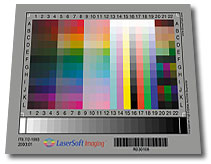Products
SilverFast is offered individually adjusted to the respective scanner model. If several scanners are operated, it is therefore necessary to purchase a corresponding number of additional licenses. Upgrade rates are also offered when purchasing a new scanner.
Overview of the available products:
| Scanner Software | HDR Software | Archiving Software | Photoshop Plug-ins |
|---|
| SilverFast SE | SilverFast HDR | SilverFast Archive Suite 1), 2) | SRDx Plug-in |
| SilverFast SE Plus 1), 2) | SilverFast HDR Studio | | |
| SilverFast Ai Studio 1), 2) | | | |
| SilverFast X-Ray | | | |
1) including: Multi-Exposure 2) optional: ICC Printer Calibration
Optional features
As marked in the table above, some products are available with additional features:
Multi-Exposure – Multi-Exposure is an exposure blending technique for scanning transparent originals like slides, negatives, and film strips with increased dynamic range. [3] This is accomplished by scanning the original multiple times with different exposure times, increasing the dynamic range and preserving detail in the light and shadow areas of the image. [4] [5] Multi-Exposure does not work with reflective originals and differs from "Multi-Sampling," which also scans multiple times but with unaltered exposure.
ICC Printer Calibration – The SilverFast ICC Printer Calibration calibrates the printer using a previously calibrated flatbed scanner as the measuring device for profiling the printer.
SilverFast Scanner Software
It can be used as a stand-alone application, as a Photoshop plug-in, or as a universal TWAIN module. Versions include:
- SilverFast SE [6] (basic edition)
- SilverFast SE Plus [7] (plus edition / with Multi-Exposure)
- SilverFast Ai Studio [8] (premium edition)
- SilverFast X-Ray (a special version of SilverFast designed to digitize radiographic films for scientific and medical radiography)
SilverFast HDR Software
SilverFast HDR is a computer program for processing 48-bit raw images. Many newer scanners are able to output the image directly with all existing data instead of breaking it down to 24-bit. This 48-bit raw image can be saved immediately and digital processing performed later.
- SilverFast HDR [9] (basic edition)
- SilverFast HDR Studio (premium edition)
SilverFast HDR contains the functionality of SilverFast Ai Studio for 48-bit raw data, such as defining output size and resolution, auto-adjusting of highlights and shadows, three-part histogram, gradation curves, selective color correction, unsharp masking, color cast removal slider, color separation, and CMYK-preview. SilverFast HDR can be used as a native plug-in for Adobe Photoshop, as a universal TWAIN module, or as a stand-alone application.
The HDR Studio has AACO (Auto-Adaptive Contrast Optimization), JPEG 2000, USMPlus (Unsharp Mask Plus), CloneTool and PrinTao.
HDRi (64Bit RAW data with infrared channel)
With version 6.6.1 any SilverFast HDR version supports the proprietary RAW data format HDRi. These 64-bit HDRi color files and 32-bit HDRi greyscale files contain additional 16-bit infrared RAW data besides the 48-bit color RAW data and 16-bit greyscale RAW data respectively. [10] [11] Therefore, a scanner with an infrared channel available to the software is necessary. This RAW format can keep any readable image information for later post-processing. The acronym "HDR" as used by SilverFast is not related to High-dynamic-range imaging, a widely used technique to increase the dynamic range of (digital) images.
The data format is:
| Format | Encoding | Compression | Color space | Color depth
(Bit per pixel) | Dynamic range
(Dimensions of 10) | Relative
gradation |
|---|
HDRi
(.tif, .tiff) | RGB (linear) | none | RGB | 64 = 48 + 16 (infrared channel) | 4,8 | 0,0014% |
| RGB (linear) | none | RGB | 32 = 16 + 16 (Infrared channel) | 4,8 | 0,0014% |
SilverFast Archiving Software
The SilverFast Archive Suite includes SilverFast Ai Studio and SilverFast HDR Studio with an integrated color management system. This package is suitable for archiving slides, negatives, and photos, whereas the post processing can take place anytime after scanning. [12]
- SilverFast Archive Suite - consisting of SilverFast Ai Studio and SilverFast HDR Studio (premium edition)
PrintTao 8
PrinTao 8 has been discontinued. PrintTao 8 was a software solution for Canon and Epson large format printers. It could be used as a stand-alone application or as a plug-in for Adobe Photoshop and Adobe Lightroom.
PrinTao 8 handled color management and all printer driver settings. It contained various printing templates like pack templates for portrait photographers or gallery wrap templates for printing on canvas.
SRDx Photoshop Plug-in
SRDx (Smart Removal of Defects) is a plug-in for Adobe Photoshop to remove defects like dust particles, specks, small scratches and finger prints from digital images.
Most dust and scratch removal tools use blur effects which degrade overall image quality. SRDx works without any unsharping effects. SRDx uses an adjustable automatic detection of dust and scratches that can be fine-tuned manually using a defect marker and a rubber tool.
SilverFast DC
SilverFast DC has been discontinued. SilverFast DC was a stand-alone software for digital camera image processing. It contained features for reading the image data from the camera, for processing, optimizing, and archiving the images on the computer, as well as for printing the edited images.
Heidelberg drum scanner
SilverFast Ai Studio supports prepress drum scanners made by Heidelberger Druckmaschinen AG (Linotype - Hell) on Microsoft Windows 2000, XP, Vista and 7, as well as Mac OS X 10.3-10.5 operating systems. Supported models include the Chromagraph 3300/3400, Tango/XL, Topaz, Nexscan, and Primescan.
This page is based on this
Wikipedia article Text is available under the
CC BY-SA 4.0 license; additional terms may apply.
Images, videos and audio are available under their respective licenses.



